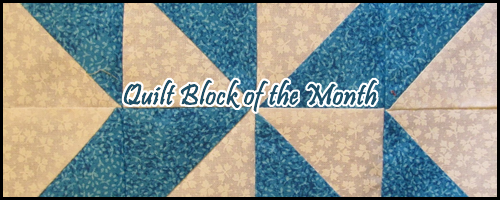Quilt Block of the Month - February 2018
Author: Elanda Tonil, February 2018
It's February!
How did January’s block go? Did you hit any snags or have any epiphanies? If you've finished your January block, feel free to post a picture, I would love to see it!
Our February Block of the Month is the Split Rail Fence! This block is another classic which is used an awful lot in quilting. It is also a great introduction to strip quilting (sewing blocks from quilts and then cutting the strips to size rather than sewing each block or section independently). Strip quilting is an easy way to make your quilt piecing go much faster!
For this block I wanted warm colors to fit the feel of valentines, but I don’t really like pink or hearts so I didn’t go full-valentines. I’ve also wanted to use that butterfly fabric for years but haven’t found the right project for it, until now. The entire block took me about an hour and a half from initial ironing of the fabric, through cutting, and piecing. It goes very quickly!
This is another block where you should be deliberate when you’re choosing fabrics. In a split rail fence block, it is very easy for two fabrics to blend together and lose their pop so make sure your fabrics are sufficiently varied to each make their mark on the block! You can also play with the placement to easily and significantly change the look of the quilt. I recommend looking at your fabrics in different configurations to see which order you like them in and then play with the orientation of the four interior blocks to figure out what you want the whole block to look like.
Without further ado, here is the split rail fence:
- Fabrics A, B, and C
Cut one strip of each fabric – 2.5” x 26”
(I just cut three strips from selvage to selvage so my strips were 2.5” x 44” and I just have a bit extra.)
- Tips
- Be sure to nest your seams when sewing the bottom two square to the top two so you get a crisp corner. I recommend pinning across that junction, one pin on each side of the nested seams within that ¼” seam allowance so it will lay as flat as possible.
- When sewing the interior sections together, press your seams away from the previous seams regardless of color.
- Fan the middle seam where all four interior sections meet in order to reduce bulk. This will make your life much easier when it comes to quilting it, as well as help your block lay flat. (If you don’t know how to fan seams, google knows of some excellent tutorials or ask in the comments and I can help you)
- You only need to square up at the end!
- In general, it’s easier to get a straighter seam if you are sewing faster rather than slower.
- Step 1
Lay your strips out and decide on the order you want the fabrics to appear. Lay Fabric A atop Fabric B, right sides together, pin along the edge (you want your pins perpendicular to the seam you’re sewing but any pinning will help), and sew the seam. Press to the dark fabric.
- Step 2
Lay your newly connected strips beside your third strip. Lay Fabric C atop Fabric B, pin, and sew along the edge farthest from Fabric A. Press to the dark fabric.
- Step 3
Verify that your center fabric, Fabric B, is now 2” wide and the outside fabrics, Fabrics A and C, are now 2.25” wide. If there are a few places that are too narrow or too wide, see if you can find four sections that are at least 6.5” long where they are accurate and just use those sections. If you cannot find enough consistent-width sections, press the fabrics flat again and pick out the problem seams, then sew them again.
- Step 4
**Your new reference point for making it square are the two seams you have just sewn!
When you are satisfied with your strips’ seams, lay your sewn strips out flat. Trim off the selvage, taking off at least an inch.
**Make sure your new edge is perpendicular to the seams you have just sewn.
Cut four blocks from this, each one should be 6.5” x 6.5”, and each one should be square relative to your new reference point seams.
- Step 5
Lay out your four squares and arrange them the way you like, making sure you’re alternating orientations. The way you orient your block will change the way it looks pretty significantly so play around and see which you like best. I liked the pinwheel pattern with this fabric (any time you’re doing a pinwheel pattern with split rail fence blocks you want to make sure your pattern isn’t forming a swastika like in the second block above), but you can play around with it and make it look however you’d like. If you make an entire split rail fence quilt the third and fourth orientations will create a fun chevron quilt.
- Step 6
Lay 2 on top of 1 and 4 on top of 3, then chain sew the right-hand seams.
Press the top seam toward 1 and the bottom seam toward 4, away from your previous seams.
- Step 7
Re-orient your block, making sure you’ve sewn the correct seams so far, then lay the bottom section atop the top, right sides together, and sew what is now the bottom seam. Fan your center seam so each end of your seam can be pressed away from the perpendicular seams.
Square it up and you’ve finished your Split Rail Fence block! How did it go? I’m always here for questions or advice, just comment or PM!
